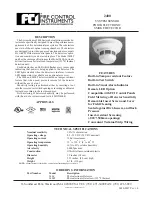
ENGLISH
17
CARE AND MAINTENANCE
Any Pit Boss® unit will give you many years of flavorful service with minimum cleaning. An important step is allowing the smoke
cabinet and cooking grids to self-clean by running the smoker at a high temperature for 5 to 10 minutes after each use. Follow
these cleaning and maintenance tips to service your smoker:
1.
HOPPER ASSEMBLY
• The hopper includes a clean-out feature to allow for ease of cleaning and change
out of pellet fuel flavors. To empty, locate the clean-out door of the drop chute on
the back side of the hopper. Place a clean, empty pail under the clean-out door, then
slowly turn the knob and allow the pellets to empty.
NOTE: Use a long handled brush or shop-vac to remove excess pellets,
sawdust, and debris for a complete clean-out.
• Check and clean off any debris from the fan air intake vent, found on the rear underside of the smoke cabinet. For
an extensive cleaning, carefully wipe off any grease build-up directly on the fan blades (see
Electric Wire Diagram
for access to electric components). This ensures airflow is sufficient to the feed system.
2.
PROBES
• Kinks or folds in the probe wires may cause damage. A meat probe not in use should be rolled up in a large, loose coil.
• Although both probes are stainless steel, do not place in the dishwasher or submerge in water. Water damage to the
internal wires will cause a probe to short-out, causing false readings. If a probe is damaged, it should be replaced.
3.
INSIDE SURFACES
• It is recommended to clean your burn pot after every few uses. This will ensure proper ignition and avoid any hard
build-up of debris or ash in the burn pot.
• Use a long-handled grill cleaning brush (brass or soft metal), remove any food or build-up from the cooking grids.
Best practice is to do this while they are still warm from the previous cook.
Grease fires are caused by too much
fallen debris on the cooking components of the smoker.
Clean the inside of your smoker on a consistent basis. In
the event you experience a grease fire, keep the smoke cabinet door closed to choke out the fire. If the fire does not
go out quickly, carefully remove the food, turn the smoker off, and shut the cabinet door until the fire is completely
out. Another way to extinguish a fire is to wrap aluminum foil around the smoke stack, closing off air to the interior.
Lightly sprinkle baking soda, if available. Check your grease tray often, and clean out as necessary. Keep in mind the
type of cooking you do. Ensure the grease exhaust tube is clear of any blockages.
IMPORTANT: The water pan may accumulate grease. Line the water pan with aluminum foil for easier clean
up after cooks. Refill and replace the water in the water pan often.
• The glass of the cabinet door is tempered and will not break with high heat; however, excessive build-up may cause
the door to not close if not cleaned regularly. Smoke and debris can be removed with frequent cleaning of the glass.
4.
OUTSIDE SURFACES
• Wipe your smoker down after each use. Use warm soapy water to cut the grease. Do not use oven cleaner, abrasive
cleansers or abrasive cleaning pads on the outside smoker surfaces.
All painted surfaces are not covered under
warranty
, but rather are part of general maintenance and upkeep. For paint scratches, wearing, or flaking of the
finish, all painted surfaces can be touched up using high heat BBQ paint.
• Use a cover to protect your smoker for complete protection! A cover is your best protection against weather and
outside pollutants. When not in use or for longterm storage, keep the unit under a cover in a garage or shed.
CLEANING FREQUENCY TIME TABLE (NORMAL USE)
ITEM
CLEANING FREQUENCY
CLEANING METHOD
Main Cabinet Glass Door
Every 2-3 Smoke Sessions
Mix Baking Soda & Vinegar, Scrub with Steel Wool (Fine)
Bottom of Main Cabinet
Every 5-6 Smoke Sessions
Scoop Out, Shop-Vac Excess Debris
















































